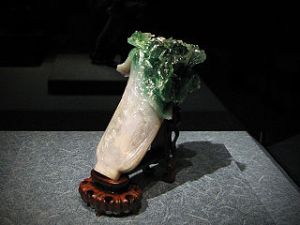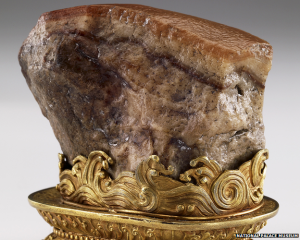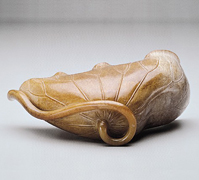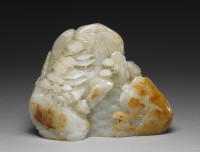Chinese jade carving reached its peak in the Qing Dynasty, a period from 1644-1911. The popularity of the skill gradually declined after 1840 until its resurgence in the 1950s. Jade carving is an important part of Chinese culture, as the stone itself has aesthetic and magical properties. Over the years it has evolved to reflect popular folk tales, customs, religion, and art. The most popular types of jade used are jadeite and nephrite. The most popular precious stones used for carving are white jade, jadeite, emerald, agate, crystal, and coral. The beauty of the raw stone is brought out through the artist’s skill in carving it, creating meticulously detailed and incredibly beautiful works of art.

The “Jadeite Cabbage” is by far one of the most famous works of its kind. The sculptor is unknown, though it is believed to have been made sometime during the Ch’ing Dynasty, and was first displayed in the Forbidden City’s Yonghe Palace in 1889. This piece is a beautiful example of the ability of the sculptor to utilize a stone’s imperfections to create a brilliant piece of art. The stone itself is very imperfect, being made of two colors and riddled with cracks and blotches and other imperfections. The artist incorporated these imperfections into the piece, making them the veins in the cabbage’s stalks and leaves. A beautiful carving is supposed to be made of one solid color, as pure a stone as a carver can find. What’s so interesting about this piece is that it was anything but perfect, undesirable even, until fell into the hands of the right carver that was able to draw the hidden potential from the stone. The piece is also thought to be an allegory of female virtue. The white stalk symbolizes purity, the leaves fertility, and the two small insects are children.

This unusual piece is called the “Meat Shaped Stone” and was created by an unknown artist during the Qing Dynasty. It was made from a piece of banded jasper, and made to look like a piece of tung-p’o meat, or stewed pork. The artist enhanced the naturally occurring layering and unique appearance of the stone, and meticulously carved it, creating the appearance of hair follicles and veins. The stone was then dyed to match the colors of the food. The end result is striking as the piece looks so realistic.

This piece, “Jade Tablet,” was believed to have been created during the late Neolithic age in China, and the artist is unknown. This piece is interesting not only because it shows how long the Chinese have valued jade for its beauty, but also because of the rich history of this piece. It is believed that the tablet was once a half finished jade knife from the Neolithic period, but was reworked in court workshops during the Ch’ien-lung reign, 1736-1795, to gain its present appearance. The tablet was once blank, until the Emperor of the time had his craftsmen engrave two poems he had written in praise of the stone onto its surface. To have an emperor himself compose not just one, but two poems glorifying a stone truly shows the spiritual power that the Chinese placed in these stones, revering them and reserving their use for the royal family.


“Cup in the Shape of a Lotus Leaf” was created sometime during the Song and Ming Dynasties, 10th-17th century, by an unknown artist. The piece is shaped like a dried lotus leaf, curling up to display the veins underneath. The stalk follows the curve of the leaf, and additionally functions as a handle. Jade carvings were used to create nearly everything from cups and bowls to decorations for tombs and hairpieces. Many of the pieces were functional like cups, bowls, hairpins, and vases.

The “Jade carving with fairy-landscape motif in mountain style” was created during the Qianlong Reign of the Qing Dynasty by an unknown artist between 1736 and 1795. This intricate piece is finely carved, and much easier to see the minute details of the landscape. It resembles the traditional shan shui style of painting, depicting natural landscapes focusing on mountains, rivers and waterfalls. The pillars of the pagodas are carved out, giving the tiny buildings space inside their frames. The detail that went into this piece is incredible, as it is only about sixteen centimeters high.
“Art in Quest of Heaven and Truth — Chinese Jades through the Ages.” Taiwan – Culture and Nature. Taiwan E-Learning and Digital Archives Program, n.d. Web. 5 Aug. 2015. <http%3A%2F%2Fculture.teldap.tw%2Fculture%2Findex.php%3Foption%3Dcom_content%26id%3D1960%3Aart-in-quest-of-heaven-and-truth-chinese-jades-through-the-ages>.
Cup in the Shape of a Lotus Leaf. 10th-17th C. Jade sculpture. National Palace Museum, Taipei.
Jade Carving with Fairy-landscape Motif in Mountain Style. 1736-1795. Jade sculpture. National Palace Museum, Taipei.
Jade Tablet. 3300-2000BCE. Jade sculpture. National Palace Museum, Taipei.
Jadeite Cabbage. 1644-1911. Jadeite sculpture. National Palace Museum, Taipei.
Meat-shaped Stone. N.d. Jasper sculpture. National Palace Museum, Taipei.
“Site Map.” Art in Quest of Heaven and Truth. National Palace Museum, n.d. Web. 5 Aug. 2015. <http%3A%2F%2Fwww.npm.gov.tw%2Fexh99%2Fchinese_jades%2Fen_sitemap.html>.
I never would have thought to write about Chinese stone carving. The pieces are very beautiful and probably took a very steady hand to make. My favorite would have to be your last piece of jade carving with a fairy motif. It almost looks like a piece of coral with its layers and different textures. I like that you wrote about how important stone carving is to Chinese culture, though this isn’t a history class I would have liked to learn more about why it is so important. This article speaks about how stone carving was first used to make necessary tools and items, but slowly developed into a very expensive art form http://arts.cultural-china.com/en/69Arts1428.html .
LikeLike
Thanks for selecting this art form. The level of detail obtained from carving stone is impressive across cultures, but the Chinese entries are particularly realistic and striking. Thanks for the information!
LikeLike
Thank you for presenting such a detailed and interesting blog about Chinese jade carving. I had a special appreciation for the “Cup in the Shape of a Lotus Leaf”. I found the detail in this piece very interesting and thought that this piece, was in particular, very representative of the amazing skill these artists had. I found an interesting piece of Jade, from what looks like a present day artist. The detail in this piece was superb and may be worth looking at: http://96.0.143.31/catalogues/060411/view.php?id=107
LikeLike
I’ve seen stone carving before but these are over the top! Was there a reason that food was a used as inspiration? I really like the cabbage carving its very unique to find a stone that is two different colors but then to turn it into something that looks god enough to eat is amazing. The Lily was also very pretty and delicate looking. I wonder how long it would take the artist to carve these works of art. Its a shame that many of the artists are unknown the works are so stunning someone should be given the credit. Awesome post on a very unusual form of art.
LikeLike